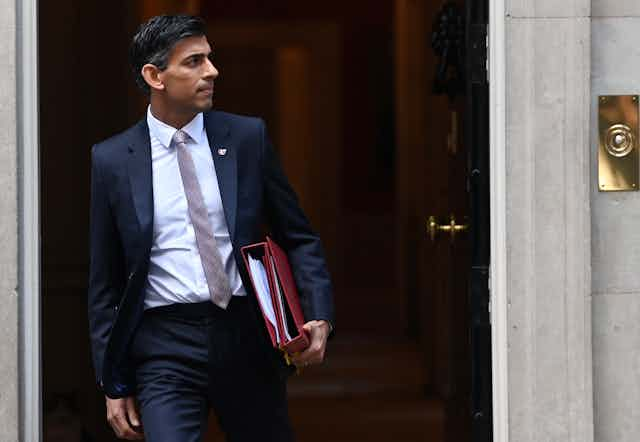Understandably, much of the focus on the autumn statement – the plan for the UK’s finances outlined by chancellor Jeremy Hunt on November 17 – is on its economic impact. But all economic policy making has considerable political significance.
The statement is the first major policy event of the Sunak government and it provides important pointers to the direction he intends to lead the country. What is also clear is that the statement creates considerable political and economic risks for his government in terms of internal party and electoral politics. So what can we take away from the statement to understand the leadership and ideas of the Sunak premiership?
The autumn statement highlights the political and economic difficulties that the government faces. The current outlook is not healthy, with Chancellor Jeremy Hunt confirming the UK is entering a recession. The Office for Budget Responsibility reports that living standards are shrinking – potentially by 7% over two years – and the economy faces sustained high levels of inflation. The government has to attempt restore the confidence of the international financial markets in its standing. At the same time, it needs to secure the support of voters facing lower living standards and poor public services.
In this context, the autumn statement is an attempt to weave a path between the failed economic dogmatism of the short-lived government of Liz Truss and the wild promises of the Boris Johnson years. Over the last decade, the centre of gravity within the Conservative party has notably shifted to the right. Electoral pragmatism means that Sunak, a fiscally-dry Conservative, cannot go headfirst down the low tax, small state road in the manner Truss wanted.
Balancing act
Instead, Sunak and Hunt have sought to strike a delicate balancing act between what markets will accept and voters will put up with. They have focused on addressing the fiscal black hole by raising taxes but at the same time have tried to maintain current spending commitments, notwithstanding this translating into actual cuts due to inflation.
Concessions have been made for important constituencies, with commitments to health, education, pensions and universal credit despite an overall real-terms decline in public spending. In the context of high inflation and considerable wage pressure, it is likely that all services will continue to feel real pressure.
The government will continue to face political pressure to spend more. Widespread industrial action and the threat of a modern-day winter of discontent, this time on a Conservative watch, have not disappeared.

Additionally, there is a growing body of evidence and increasing chorus of voices from business and elsewhere, arguing that Brexit has damaged the UK economy and is partially responsible for the current economic malaise. The autumn statement is based on continuing to downplay a “Brexit effect” on UK economic performance.
The Sunak vision of a post-Brexit political economy is closer to Johnson than Truss. The new prime minister appears committed to Johnson’s “levelling up” agenda (though with considerably reduced resources and a very significant cut in spending post-2024). He also seems to recognise that spending on research and development in key areas will drive innovation in the economy.
So this is neither a completely free market or interventionist approach to growing the economy. It is one where public spending is creating incentives to innovate and to drive market growth. At the same time, there is no joined-up attempt to address the supply side problems created by leaving the European single market or the war in Ukraine with policies that will reshape Britain’s post-Brexit economy.
Electoral pressures
Sunak has focused on maintaining the Johnson electoral coalition, but risks angering those affected by tax rises, alongside those on the right of his party. A number of MPs are already highly critical of tax increases, extra public spending and commitments to low carbon energy. A real danger for Sunak is that in attempting to broaden his government’s electoral appeal, he fails to resolve the fundamental divisions within his party between those committed to Truss’s radicalism and those who favour a more pragmatic approach.
The statement has also set an elephant trap for Labour. By delaying £30 billion in spending cuts until after the 2025 election, Labour is going to face difficult questions in the campaign lead-up about its spending plans. Will it reverse tax cuts and reduce public spending or will it need further tax increases to improve public services? Labour is in danger of being tied into Conservative commitments, which will limit its options.
The approach set out in the autumn statement by Jeremy Hunt is somewhat different to that offered by Sunak during last summer’s Conservative party leadership campaign. Then, he presented himself as a low tax, small state supporter. Today this vision is hampered both by the need to show economic competence to the markets and to improve public services in order to meet voter expectations.
The commitment to fiscal conservatism is a difficult political space in such circumstances. It has limited the number of tools available to him to unite the Conservative party and to build the electoral coalition necessary to win the next election. It may also mean that he ends up being the third Conservative prime minister to fail to put in place a convincing vision of what a post-Brexit United Kingdom should be.

